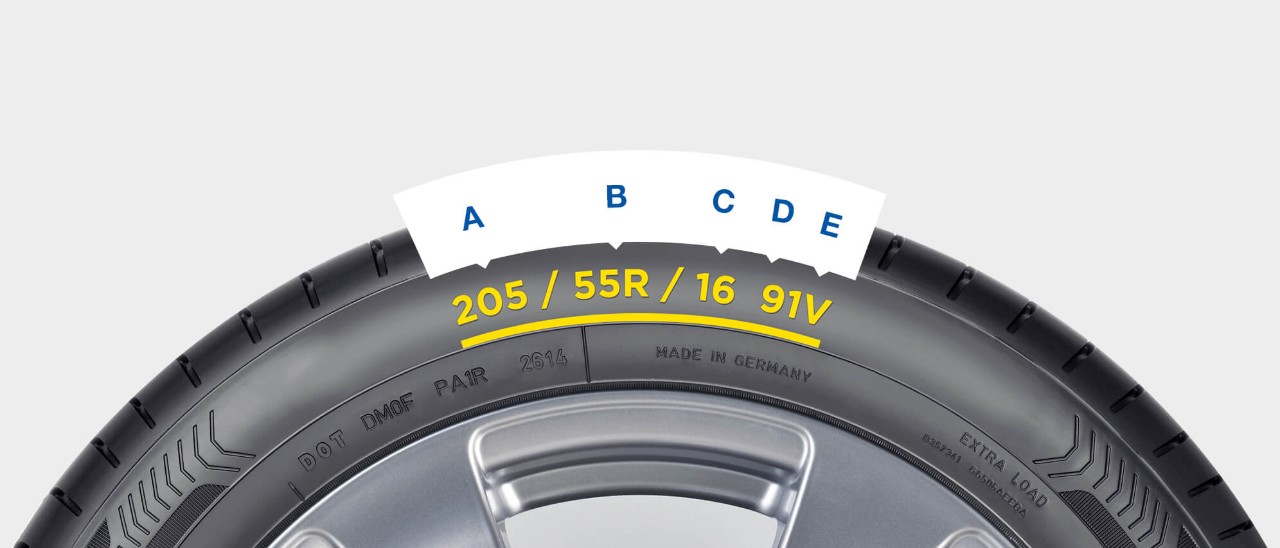Your tire’s sidewall contains all the information about your tire that you’ll need. Here’s a little guide to what all those numbers and letters mean:

The width of your tire, in millimetres, measured from sidewall to sidewall.
This is the ratio of the tire’s cross-section to its width, expressed as a percentage. An aspect ratio of 65, for example, indicates that the tire’s height is 65% of its width.
The diameter (height) of the wheel in inches.
Your tire’s load index relates to its maximum carrying capacity (in kg). You’ll find the load rating of your tire on the sidewall, just to the right of the diameter.
For example, a tire with a load index of 91 can carry 615kg of weight.
Load ratings and speed ratings should be looked at together when you buy a new tire. Also remember to check your manufacturer’s recommendations.
The speed rating is the maximum speed for a tire when it is correctly inflated and being used under load. The speed rating is the letter at the end of the sidewall, after the load index number. A tire with a speed rating of V, for example, has a maximum speed of 240 km/h.
When buying new tires, make sure you match their speed rating with the speed capabilities of your vehicle.
It may be possible to fit tires with higher load indexes and different speed ratings to those indicated in your vehicle’s manufacturer documentation.
However, always check first in your vehicle’s manufacturer documentation if these tires may be fitted on your vehicle and if using these tires is permitted under your local laws and regulations. You should also comply with all applicable requirements of your local laws and regulations and not exceed the specifications of these tires as well as those indicated in your vehicle’s manufacturer documentation in terms of speed and load. Your dealer may help you verifying this before purchasing or fitting tires.
Is it possible to fit tires with a higher speed rating than my manufacturer recommends?
Yes, this may be possible. However, always check first in your vehicle’s manufacturer documentation if these tires may be fitted on your vehicle.
Is it possible to fit tires with a higher load index than my manufacturer recommends?
Yes, this may be possible. However, always check first in your vehicle’s manufacturer documentation if these tires may be fitted on your vehicle.
Is it possible to fit tires with a higher speed rating and a higher load index than my manufacturer recommends?
Yes, this may be possible. However, always check first in your vehicle’s manufacturer documentation if these tires may be fitted on your vehicle.
Is it possible to fit tires with a lower speed rating than my manufacturer recommends?
Yes, you can use all-season or winter (M+S) tires that have a lower speed rating so long as: a) a sticker that shows the maximum speed limit is in the driver’s field of vision and b) you don’t drive the vehicle faster than the maximum speed limit. However, always check first in your vehicle’s manufacturer documentation if these tires may be fitted on your vehicle.
Is it possible to fit tires with a higher load index and a lower speed rating than my manufacturer recommends?
Yes, you can fit tires that have a higher load index and a lower speed rating.
You can use all-season or winter (M+S) tires that have a lower speed rating so long as: a) a sticker that shows the maximum speed limit is in the driver’s field of vision and b) you don’t drive the vehicle faster than the maximum speed limit.
However, always check first in your vehicle’s manufacturer documentation if these tires may be fitted on your vehicle.
Check your vehicle owner's manual to determine the load limits. Overloading your vehicle places stress on your tires and other critical vehicle components. It can cause poor handling, increased fuel consumption and may cause tire failure. It can also result in severe cracking, component separation or "blowout."
A “P” or no letter at all indicates a passenger car tire.
The letter “R” stands for radial. Almost every new tire built today is a radial tire.
This tells you that the tire conforms to the standards of the United Nations Economic Commission for Europe (U.N.E.C.E.) in relation to pneumatic tires.
This is the maximum inflation pressure for your tire. Consult your vehicle's manual for more information about recommended tire pressure because it can have an impact on your car’s handling, turning, braking and fuel efficiency.
The letters “TWI” show the location of the tire’s tread wear indicators. You should check these indicators regularly to ensure there’s enough tread on your tires. In most EU countries the minimum tread depth 1.6mm.
This four-digit code tells you the week and year that your tire was manufactured.